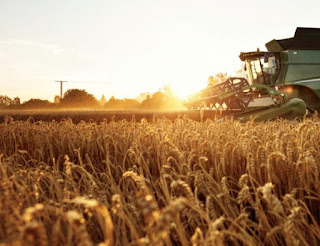Combines harvest the crop once the kernels have dried to 15 percent moisture or less. Harvesting of winter wheat starts in May and usually is completed by late July. Harvesting of spring wheat begins in late July and is completed by late August.
Wheat should be harvested without delay when it reaches maturity and begins to dry down to market moisture contents. A moisture meter is very useful to give a quick determination of crop condition. After wheat begins to dry in the field, repeated precipitation and drying begins to decrease quality and test weight.
Wheat is typically harvested in the 13 to 15 percent moisture content range. It also can be successfully harvested at higher moisture contents, provided it is dried quickly enough to prevent spoilage and/or sprouting.
Harvest begins with the cutting of a standing crop. Harvest may be accomplished in a single step by straight (direct) combining or in a series of steps that may include windrowing (swathing), combining, and drying the grain to a safe moisture level for storage. Straight combining is the preferred harvest method in most wheat production areas of the world.
Crops left standing un-harvested start to show diminishing quantitative and qualitative returns through shatter losses and attacks by insects, mould, birds and rodents. It is therefore important to complete harvesting as soon as possible.
Freshly harvested wheat grain should be dried to a moisture content of 14 percent or less within 48 hours to prevent sprouting and spoilage. High moisture wheat (>17%) can be dried with both high-speed and bin drying equipment.
Harvesting wheat
Soft Drinks: Definition, Ingredients, and Standards
-
In the United States, the term *soft drinks* is commonly applied to
beverages that contain no alcohol. These drinks are widely consumed across
all age gr...






